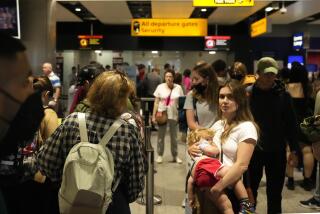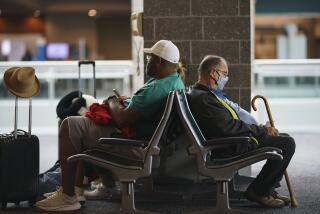Maladies of Those on the Move
Call it the price of wanderlust. Those who travel frequently, whether for business or pleasure, can recite a long list of maladies, say specialists who care for them. Yet most of the health complaints are simple to treat or are preventable, and serious problems, such as blood clots, occur much less frequently during travel than garden-variety conditions such as dry eyes.
Here are a few of the ailments physicians hear about from travelers, along with suggestions for relief:
* Nearly everyone forced to sit for three or four hours on a plane or in a car at some point experiences pain or discomfort in the back or the neck, said Dr. Victor Kovner, a Studio City internist who specializes in travel medicine.
If traveling by car, stop every couple of hours and stretch; if by air, a stroll up the aisle every hour is a good idea “unless you’re sleeping,” Kovner said.
“Wear loose clothing and stay well-hydrated,” said Dr. Russell Rayman, executive director of the Aerospace Medical Assn. in Alexandria, Va.
* Traveler’s diarrhea is an often-discussed problem, but Kovner said he hears more complaints about constipation from his frequent-traveler patients. It can be brought on, he said, by time zone changes, inactivity and other factors. “People often limit their fluid intake because they don’t want to have to go to the bathroom (so much),” he said.
To ward off constipation, Kovner advises eating a high-fiber diet and drinking plenty of water.
If the problem strikes anyway, consider the use of over-the-counter glycerin rectal suppositories or bisacodyl preparations (one brand name is Dulcolax), which usually work within a hour, offering the traveler needed control. Kovner recommends them over oral laxatives that are often not predictable, in that they can act quickly or take several hours. However, suppositories probably aren’t feasible for very hot climates, since they are likely to melt. In that case he recommends using oral laxatives.
* Travelers who wear contact lenses are particularly susceptible to dry or irritated eyes. Pack and use wetting drops or other lubricants when eyes feel dry, experts said.
* “It’s best not to fly with a severe upper respiratory infection,” Rayman said, although it’s sometimes not avoidable. To ward off the stuffed-up feeling that can accompany travel at altitude, “use nasal spray prior to flight and prior to landing,” Rayman said.
On planes, air is often low in humidity and “the membranes of the nose and upper airways get dried out,” said Dr. John Dalton, a pulmonologist and director of the respiratory therapy department and pulmonary function laboratory at Santa Monica Hospital Medical Center.
Travelers are more prone to coughing and sneezing, he said, partly due to the close quarters and contact with many people. During flu season, anyone with underlying lung problems should be especially careful to get a flu shot before traveling, Dalton said.
Travel to cities where air pollution is severe--Mexico City, for example--tends to bring on more respiratory problems, Dalton said.
Breathing in and swallowing dust, especially when traveling on unpaved roads or in very dry environments, may lead to nausea and fatigue, according to the Centers for Disease Control and Prevention. In turn, there may be increased susceptibility to upper respiratory tract infections.
* For travelers who have trouble sleeping after arriving at their destination, some experts suggest asking their physician about using prescription sleeping pills for a very short time on their next journey.
Some experts recommend trying sleeping pills at home before travel to determine, in advance, whether the pills prompt unpleasant side effects.
Light therapy is worth a try, too, according to sleep specialists. After arrival, stay up if it is not bedtime at your destination. Stay in sunlight to try to reset your body clock.
Ask for a room away from elevators, ice machines and bars, which can wake you, especially if sleep is intermittent.
More serious conditions, while often feared by travelers, are not nearly as common as minor health complaints, doctors said.
Late last year, blood clots lodged in the lungs of former U.S. Vice President Dan Quayle, 48, after air travel. The clotting problem is “unusual in someone that young,” Dalton said. But clots can occur, he said, under a number of conditions. There could be an injury to the vessel in an extremity, leading to a clot. Blood might stagnate in the lower limbs and then a clot might form. A clot can break loose and travel to the lungs, causing chest pain and shortness of breath. The clot is usually detected on a lung scan, Dalton said. For clots to occur without another underlying condition, Dalton added, is unusual.
The Healthy Traveler appears the second and fourth week of every month.
More to Read
Sign up for The Wild
We’ll help you find the best places to hike, bike and run, as well as the perfect silent spots for meditation and yoga.
You may occasionally receive promotional content from the Los Angeles Times.






